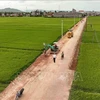The Mekong Delta City of Can Tho, one of the hardest hit by climate change between now and 2050, has been upgrading and expanding its urban areas in an eco-friendly fashion that adapts to the changing climate.
Since the outset of 2015, the city has worked with neighbouring localities to assess the impacts of climate change on the region and adopt suitable solutions, said the provincial Department of Natural Resources and Environment.
Accordingly, any urban planning activity must take into full account such factors as landform stability and sea level rise while designing suitable irrigation systems and waterway traffic together with flood-proof residential clusters, installing warnings at buildings in flood-prone areas and preparing for emergencies.
Some 24 culverts, two ports in Tra Noc and Binh Thuy Rivers and six pumping stations will be constructed while canal systems within the city will be dredged and upgraded by 2017 to boost the capacity of flood drainage.
An additional 152 culverts, 29 pumping stations and 614 kilometres of dykes are scheduled to be built beyond 2017.
The Mekong Delta city also works to maintain sufficient water reserves and minimise floods.
Experts predicted that by 2050, many provinces in the Mekong Delta, including Can Tho, would be 0.8-1 metres under sea level.
Climate change is forecast to reduce the Mekong River’s flow by 2-24 percent during dry seasons and increase 7-15 percent during flood seasons, burdening agricultural production in the region.-VNA
Since the outset of 2015, the city has worked with neighbouring localities to assess the impacts of climate change on the region and adopt suitable solutions, said the provincial Department of Natural Resources and Environment.
Accordingly, any urban planning activity must take into full account such factors as landform stability and sea level rise while designing suitable irrigation systems and waterway traffic together with flood-proof residential clusters, installing warnings at buildings in flood-prone areas and preparing for emergencies.
Some 24 culverts, two ports in Tra Noc and Binh Thuy Rivers and six pumping stations will be constructed while canal systems within the city will be dredged and upgraded by 2017 to boost the capacity of flood drainage.
An additional 152 culverts, 29 pumping stations and 614 kilometres of dykes are scheduled to be built beyond 2017.
The Mekong Delta city also works to maintain sufficient water reserves and minimise floods.
Experts predicted that by 2050, many provinces in the Mekong Delta, including Can Tho, would be 0.8-1 metres under sea level.
Climate change is forecast to reduce the Mekong River’s flow by 2-24 percent during dry seasons and increase 7-15 percent during flood seasons, burdening agricultural production in the region.-VNA



















